Polystyrene
 | |
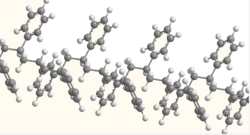 | |
| Names | |
|---|---|
| IUPAC name
Poly(1-phenylethene) | |
| Other names
Thermocol | |
| Identifiers | |
| 9003-53-6 | |
| Abbreviations | PS |
| ECHA InfoCard | 100.105.519 |
| Properties | |
| (C8H8)n | |
| Density | 0.96–1.04 g/cm3 |
| Melting point | ~ 240 °C (464 °F; 513 K)[1] (decomposes at lower temperature) |
| Thermal conductivity | 0.033 W/(m·K) (foam, ρ 0.05 g/cm3)[2] |
| Refractive index (nD) |
1.6; dielectric constant 2.6 (1 kHz – 1 GHz)[3] |
| Related compounds | |
| Related compounds |
Styrene (monomer) |
| Except where otherwise noted, data are given for materials in their standard state (at 25 °C [77 °F], 100 kPa). | |
| Infobox references | |
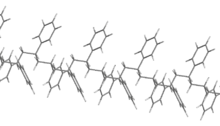

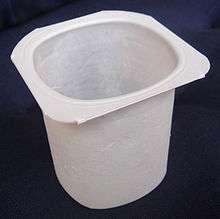
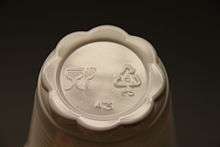
Polystyrene (PS) /ˌpɒliˈstaɪriːn/ is a synthetic aromatic polymer made from the monomer styrene. Polystyrene can be solid or foamed. General-purpose polystyrene is clear, hard, and rather brittle. It is an inexpensive resin per unit weight. It is a rather poor barrier to oxygen and water vapor and has a relatively low melting point.[4] Polystyrene is one of the most widely used plastics, the scale of its production being several million tonnes per year.[5] Polystyrene can be naturally transparent, but can be colored with colorants. Uses include protective packaging (such as packing peanuts and CD and DVD cases), containers (such as "clamshells"), lids, bottles, trays, tumblers, and disposable cutlery.[4]
As a thermoplastic polymer, polystyrene is in a solid (glassy) state at room temperature but flows if heated above about 100 °C, its glass transition temperature. It becomes rigid again when cooled. This temperature behavior is exploited for extrusion (as in Styrofoam) and also for molding and vacuum forming, since it can be cast into molds with fine detail.
Polystyrene is very slow to biodegrade and is therefore a focus of controversy among environmentalists. It is increasingly abundant as a form of litter in the outdoor environment, particularly along shores and waterways, especially in its foam form, and also in increasing quantities in the Pacific Ocean.[6]
History
Polystyrene was discovered in 1839 by Eduard Simon,[7] an apothecary from Berlin.[8] From storax, the resin of the American sweetgum tree Liquidambar styraciflua, he distilled an oily substance, a monomer that he named styrol. Several days later, Simon found that the styrol had thickened into a jelly he dubbed styrol oxide ("Styroloxyd") because he presumed an oxidation. By 1845 Jamaican-born chemist John Buddle Blyth and German chemist August Wilhelm von Hofmann showed that the same transformation of styrol took place in the absence of oxygen.[9] They called the product "metastyrol"; analysis showed that it was chemically identical to Simon's Styroloxyd.[10] In 1866 Marcelin Berthelot correctly identified the formation of metastyrol/Styroloxyd from styrol as a polymerization process.[11] About 80 years later it was realized that heating of styrol starts a chain reaction that produces macromolecules, following the thesis of German organic chemist Hermann Staudinger (1881–1965). This eventually led to the substance receiving its present name, polystyrene.
The company I. G. Farben began manufacturing polystyrene in Ludwigshafen, about 1931, hoping it would be a suitable replacement for die-cast zinc in many applications. Success was achieved when they developed a reactor vessel that extruded polystyrene through a heated tube and cutter, producing polystyrene in pellet form.
In 1941, Dow Chemical invented a Styrofoam process.[12]
Before 1949, the chemical engineer Fritz Stastny (1908–1985) developed pre-expanded PS beads by incorporating aliphatic hydrocarbons, such as pentane. These beads are the raw material for moulding parts or extruding sheets. BASF and Stastny applied for a patent that was issued in 1949. The moulding process was demonstrated at the Kunststoff Messe 1952 in Düsseldorf. Products were named Styropor.
The crystal structure of isotactic polystyrene was reported by Giulio Natta.[13]
In 1954, the Koppers Company in Pittsburgh, Pennsylvania, developed expanded polystyrene (EPS) foam under the trade name Dylite.[14]
In 1960, Dart Container, the largest manufacturer of foam cups, shipped their first order.[15]
In 1988, the first U.S. ban of general polystyrene foam was enacted in Berkeley, California.[16]
Structure
In chemical terms, polystyrene is a long chain hydrocarbon wherein alternating carbon centers are attached to phenyl groups (the name given to the aromatic ring benzene). Polystyrene's chemical formula is (C
8H
8)
n; it contains the chemical elements carbon and hydrogen.
The material's properties are determined by short-range van der Waals attractions between polymers chains. Since the molecules are long hydrocarbon chains that consist of thousands of atoms, the total attractive force between the molecules is large. When heated (or deformed at a rapid rate, due to a combination of viscoelastic and thermal insulation properties), the chains are able to take on a higher degree of conformation and slide past each other. This intermolecular weakness (versus the high intramolecular strength due to the hydrocarbon backbone) confers flexibility and elasticity. The ability of the system to be readily deformed above its glass transition temperature allows polystyrene (and thermoplastic polymers in general) to be readily softened and molded upon heating.
Extruded polystyrene is about as strong as an unalloyed aluminium, but much more flexible and much lighter (1.05 g/cm3 vs. 2.70 g/cm3 for aluminium).
Polymerization
Polystyrene results when styrene monomers interconnect. In the polymerization, the carbon-carbon pi bond (in the vinyl group) is broken and a new carbon-carbon single (sigma) bond is formed, attaching another styrene monomer to the chain. The newly formed sigma bond is much stronger than the pi bond that was broken, thus it is very difficult to depolymerize polystyrene. About a few thousand monomers typically comprise a chain of polystyrene, giving a molecular weight of 100,000–400,000.
A 3-D model would show that each of the chiral backbone carbons lies at the center of a tetrahedron, with its 4 bonds pointing toward the vertices. Consider that the -C-C- bonds are rotated so that the backbone chain lies entirely in the plane of the diagram. From this flat schematic, it is not evident which of the phenyl (benzene) groups are angled outward from the plane of the diagram, and which ones are inward. The isomer where all of the phenyl groups are on the same side is called isotactic polystyrene, which is not produced commercially.
Atactic polystyrene
The only commercially important form of polystyrene is atactic, in which the phenyl groups are randomly distributed on both sides of the polymer chain. This random positioning prevents the chains from aligning with sufficient regularity to achieve any crystallinity. The plastic has a glass transition temperature Tg of ~90 °C. Polymerization is initiated with free radicals.[5]
Syndiotactic polystyrene
Ziegler-Natta polymerization can produce an ordered syndiotactic polystyrene with the phenyl groups positioned on alternating sides of the hydrocarbon backbone. This form is highly crystalline with a Tm of 270 °C (518 °F). Syndiotactic polystyrene resin is currently produced under the trade name XAREC by Idemitsu corporation. Syndiotactic polystyrene is prepared by combining a metallocene catalyst with a styrene monomer to generate a polystyrene chain with a syndiotactic structure.[17]
Degradation
Polystyrene is chemically very inert, being resistant to acids and bases but is easily dissolved by many chlorinated solvents, and many aromatic hydrocarbon solvents. Because of its resilience and inertness, it is used for fabricating many objects of commerce. It is attacked by many organic solvents, which dissolve the polymer. Foamed polystyrene is used for packaging chemicals.
Like all organic compounds, polystyrene burns to give carbon dioxide and water vapor. Polystyrene, being an aromatic hydrocarbon, typically combusts incompletely as indicated by the sooty flame.
Biodegradation
Polystyrene is generally non-biodegradable. There are a couple of exceptions:
To quote:[18]
Methanogenic consortia have been shown to degrade styrene as sole carbon source (Grbić-Galić et al. 1990). In this case styrene degraded to a range of organic intermediates and carbon dioxide. Taking the carbon dioxide figures as a representation of the amount of styrene that had completely degraded to gas as is of interest here, rates of styrene degradation ranged from 0.14 to 0.4 a−1. This is an order of magnitude faster than the most rapid rate of polystyrene degradation identified (Kaplan et al. 1979, Sielicki et al. 1978). It is consistent with the T2GGM polystyrene degradation model (Quintessa and Geofirma 2011b), which considers the rate-limiting step for polystyrene degradation to be the breakup of polystyrene, rather than the degradation of styrene.
Mealworms have been shown to be able to eat polystyrene and degrade it within their larval gut.[19]
Pseudomonas putida is capable of converting styrene oil into the biodegradable plastic PHA.[20][21][22] This may someday be of use in the effective disposing of polystyrene foam.
Forms produced
| Properties | |
|---|---|
| Density of EPS | 16–640 kg/m3[23] |
| Young's modulus (E) | 3000–3600 MPa |
| Tensile strength (st) | 46–60 MPa |
| Elongation at break | 3–4% |
| Notch test | 2–5 kJ/m2 |
| Glass transition temperature | 100 °C[24] |
| Vicat B | 90 °C[25] |
| Linear expansion coefficient (a) | 8×10−5 /K |
| Specific heat (c) | 1.3 kJ/(kg·K) |
| Water absorption (ASTM) | 0.03–0.1 |
| Decomposition | X years, still decaying |
Polystyrene is commonly injection molded, vacuum formed, or extruded, while expanded polystyrene is either extruded or molded in a special process. Polystyrene copolymers are also produced; these contain one or more other monomers in addition to styrene. In recent years the expanded polystyrene composites with cellulose[26][27] and starch[28] have also been produced. Polystyrene is used in some polymer-bonded explosives (PBX).
Sheet or molded polystyrene
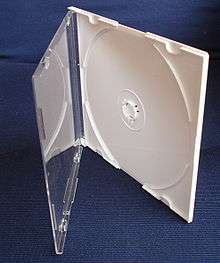
Polystyrene (PS) is used for producing disposable plastic cutlery and dinnerware, CD "jewel" cases, smoke detector housings, license plate frames, plastic model assembly kits, and many other objects where a rigid, economical plastic is desired. Production methods include thermoforming (vacuum forming) and injection molding.
Polystyrene Petri dishes and other laboratory containers such as test tubes and microplates play an important role in biomedical research and science. For these uses, articles are almost always made by injection molding, and often sterilized post-molding, either by irradiation or by treatment with ethylene oxide. Post-mold surface modification, usually with oxygen-rich plasmas, is often done to introduce polar groups. Much of modern biomedical research relies on the use of such products; they therefore play a critical role in pharmaceutical research.[29]
Foams
Polystyrene foams are good thermal insulators and are therefore often used as building insulation materials, such as in insulating concrete forms and structural insulated panel building systems. Grey polystyrene foam, incorporating graphite has superior insulation properties.[30] They are also used for non-weight-bearing architectural structures (such as ornamental pillars). PS foams also exhibit good damping properties, therefore it is used widely in packaging. The trademark Styrofoam by Dow Chemical Company is informally used (mainly US & Canada) for all foamed polystyrene products, although strictly it should only be used for 'extruded closed-cell' polystyrene foams made by Dow Chemicals.
Expanded polystyrene (EPS)
Expanded polystyrene (EPS) is a rigid and tough, closed-cell foam. It is usually white and made of pre-expanded polystyrene beads. EPS is used for many applications e.g. trays, plates, bowls and fish boxes. Other uses include molded sheets for building insulation and packing material ("peanuts") for cushioning fragile items inside boxes. Sheets are commonly packaged as rigid panels (size 4 by 8 or 2 by 8 feet in the United States), which are also known as "bead-board".
Due to its technical properties such as low weight, rigidity, and formability, EPS can be used in a wide range of different applications. Its market value is likely to rise to more than US$15 billion by 2020.[31]
Thermal conductivity is measured according to EN 12667. Typical values range from 0.032 to 0.038 W/(m·K) depending on the density of the EPS board. The value of 0.038 W/(m·K) was obtained at 15 kg/m3 while the value of 0.032 W/(m·K) was obtained at 40 kg/m3 according to the data sheet of K-710 from StyroChem Finland. Adding fillers (graphites, aluminium, or carbons) has recently allowed the thermal conductivity of EPS to reach around 0.030–0.034 (as low as 0.029) and as such has a grey/black color which distinguishes it from standard EPS. Several EPS producers have produced a variety of these increased thermal resistance EPS usage for this product in the UK & EU.
Water vapor diffusion resistance (μ) of EPS is around 30–70.
ICC-ES (International Code Council Evaluation Service) requires EPS boards used in building construction meet ASTM C578 requirements. One of these requirements is that the oxygen index of EPS as measured by ASTM D2863 be greater than 24 volume %. Typical EPS has an oxygen index of around 18 volume %; thus, a flame retardant is added to styrene or polystyrene during the formation of EPS.
The boards containing a flame retardant when tested in a tunnel using test method UL 723 or ASTM E84 will have a flame spread index of less than 25 and a smoke-developed index of less than 450. ICC-ES requires the use of a 15-minute thermal barrier when EPS boards are used inside of a building.
According to EPS-IA ICF organization, the typical density of EPS used for insulated concrete forms is 1.35 to 1.80 pcf. This is either Type II or Type IX EPS according to ASTM C578. EPS blocks or boards used in building construction are commonly cut using hot wires.[32]
Extruded polystyrene foam
Extruded polystyrene foam (XPS) consists of closed cells, offers improved surface roughness and higher stiffness and reduced thermal conductivity. The density range is about 28–45 kg/m3.
Extruded polystyrene material is also used in crafts and model building, in particular architectural models. Because of the extrusion manufacturing process, XPS does not require facers to maintain its thermal or physical property performance. Thus, it makes a more uniform substitute for corrugated cardboard. Thermal conductivity varies between 0.029 and 0.039 W/(m·K) depending on bearing strength/density and the average value is ~0.035 W/(m·K).
Water vapour diffusion resistance (μ) of XPS is around 80–250 and so makes it more suitable to wetter environments than EPS.
Water absorption of polystyrene foams
Although it is a closed-cell foam, both expanded and extruded polystyrene are not entirely waterproof or vaporproof.[33] In expanded polystyrene there are interstitial gaps between the expanded closed-cell pellets that form an open network of channels between the bonded pellets, and this network of gaps can become filled with liquid water. If the water freezes into ice, it expands and can cause polystyrene pellets to break off from the foam. Extruded polystyrene is also permeable by water molecules and can not be considered a vapor barrier.[34]
Waterlogging commonly occurs over a long period of time in polystyrene foams that are constantly exposed to high humidity or are continuously immersed in water, such as in hot tub covers, in floating docks, as supplemental flotation under boat seats, and for below-grade exterior building insulation constantly exposed to groundwater.[35] Typically an exterior vapor barrier such as impermeable plastic sheeting or a sprayed-on coating is necessary to prevent saturation.
Copolymers
Pure polystyrene is brittle, but hard enough that a fairly high-performance product can be made by giving it some of the properties of a stretchier material, such as polybutadiene rubber. The two such materials can never normally be mixed because of the small mixing entropy of polymers (see Flory-Huggins solution theory), but if polybutadiene is added during polymerization it can become chemically bonded to the polystyrene, forming a graft copolymer, which helps to incorporate normal polybutadiene into the final mix, resulting in high-impact polystyrene or HIPS, often called "high-impact plastic" in advertisements. One commercial name for HIPS is Bextrene. Common applications of HIPS include toys and product casings. HIPS is usually injection molded in production. Autoclaving polystyrene can compress and harden the material.
Several other copolymers are also used with styrene. Acrylonitrile butadiene styrene or ABS plastic is similar to HIPS: a copolymer of acrylonitrile and styrene, toughened with polybutadiene. Most electronics cases are made of this form of polystyrene, as are many sewer pipes. SAN is a copolymer of styrene with acrylonitrile, and SMA one with maleic anhydride. Styrene can be copolymerized with other monomers; for example, divinylbenzene can be used for cross-linking the polystyrene chains to give the polymer used in Solid phase peptide synthesis.
Oriented polystyrene
Oriented polystyrene (OPS) is produced by stretching extruded PS film, improving visibility through the material by reducing haziness and increasing stiffness. This is often used in packaging where the manufacturer would like the consumer to see the enclosed product. Some benefits to OPS are that it is less expensive to produce than other clear plastics such as PP, PET, and HIPS, and it is less hazy than HIPS or PP. The main disadvantage to OPS is that it is brittle, and will crack or tear easily.
Environmental issues
Production
Polystyrene foams are produced using blowing agents that form bubbles and expand the foam. In expanded polystyrene, these are usually hydrocarbons such as pentane, which may pose a flammability hazard in manufacturing or storage of newly manufactured material, but have relatively mild environmental impact. Extruded polystyrene is usually made with hydrofluorocarbons (HFC-134a),[36] which have global warming potentials of approximately 1000–1300 times that of carbon dioxide.[37]
Non-biodegradable
Discarded polystyrene does not biodegrade for hundreds of years and is resistant to photolysis.[38]
Litter
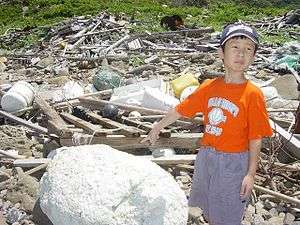
Animals do not recognize polystyrene foam as an artificial material and may even mistake it for food.[39] Polystyrene foam blows in the wind and floats on water, due to its specific gravity. It can have serious effects on the health of birds or marine animals that swallow significant quantities.[39]
Reducing
Restricting the use of foamed polystyrene takeout food packaging is a priority of many solid waste environmental organizations. Efforts have been made to find alternatives to polystyrene, especially foam in restaurant settings. The original impetus was to eliminate chlorofluorocarbons (CFC), which was a former component of foam.
United States
In 1987, Berkeley, California banned CFC food containers.[40] The following year, Suffolk County, New York became the first U.S. locality to ban polystyrene.[41] However, legal challenges by the Society of the Plastics Industry[42] kept it from going into effect until at last it was delayed when the Republican and Conservative parties became a majority of the county legislature.[43] In the meantime, Berkeley became the first city to ban all foam food containers.[16] As of 2006, about one hundred localities in the United States including Portland, Oregon and San Francisco currently have some sort of ban on polystyrene foam in restaurants. For instance, in 2007 Oakland, California required restaurants to switch to disposable food containers that will biodegrade if added to food compost.[44] In 2013, San Jose became reportedly the largest city in the country to ban polystyrene foam food containers.[45] Some communities have implemented wide polystyrene bans, such as Freeport, Maine, which did so in 1990.[46]
The U.S. Green Restaurant Association does not allow polystyrene foam to be used as part of their certification standard.[47] Several green leaders, from the Dutch Ministry of the Environment to Starbucks' Green Team, advise that individuals reduce their environmental impact by using reusable coffee cups.[48]
Outside the United States
China banned expanded polystyrene takeout/takeaway containers and tableware around 1999. However, compliance has been a problem and, in 2013, the Chinese plastics industry is actively lobbying to get the ban repealed.[49]
India and Taiwan also banned polystyrene foam food service ware prior to 2007.[50]
Recycling

In general, polystyrene is not accepted in curbside collection recycling programs, and is not separated and recycled where it is accepted. In Germany, polystyrene is collected, as a consequence of the packaging law (Verpackungsverordnung) that requires manufacturers to take responsibility for recycling or disposing of any packaging material they sell.
Most polystyrene products are currently not recycled due to the lack of incentive to invest in the compactors and logistical systems required. Due to the low density of polystyrene foam, it is not economical to collect. However, if the waste material goes through an initial compaction process, the material changes density from typically 30 kg/m3 to 330 kg/m3 and becomes a recyclable commodity of high value for producers of recycled plastic pellets. Expanded polystyrene scrap can be easily added to products such as EPS insulation sheets and other EPS materials for construction applications; many manufacturers cannot obtain sufficient scrap because of collection issues. When it is not used to make more EPS, foam scrap can be turned into products such as clothes hangers, park benches, flower pots, toys, rulers, stapler bodies, seedling containers, picture frames, and architectural molding from recycled PS.[51] Currently, around 100 tonnes of EPS are recycled every month in the UK.[52]
Recycled EPS is also used in many metal casting operations. Rastra is made from EPS that is combined with cement to be used as an insulating amendment in the making of concrete foundations and walls. American manufacturers have produced insulating concrete forms made with approximately 80% recycled EPS since 1993.
Incineration
If polystyrene is properly incinerated at high temperatures (up to 1000 °C[53]) and with plenty of air[53] (14 m3/kg), the chemicals generated are water, carbon dioxide, and possibly small amounts of residual halogen-compounds from flame-retardants.[53] If only incomplete incineration is done, there will also be leftover carbon soot and a complex mixture of volatile compounds.[54] According to the American Chemistry Council, when polystyrene is incinerated in modern facilities, the final volume is 1% of the starting volume; most of the polystyrene is converted into carbon dioxide, water vapor, and heat. Because of the amount of heat released, it is sometimes used as a power source for steam or electricity generation.[53][55]
When polystyrene was burned at temperatures of 800–900 °C (the typical range of a modern incinerator), the products of combustion consisted of "a complex mixture of polycyclic aromatic hydrocarbons (PAHs) from alkyl benzenes to benzoperylene. Over 90 different compounds were identified in combustion effluents from polystyrene."[56]
Safety
Health
According to a plastic food service products website of the American Chemistry Council:
Based on scientific tests over five decades, government safety agencies have determined that polystyrene may be safe for use in foodservice products. For example, polystyrene comes close to meeting the standards of the U.S. Food and Drug Administration and the European Commission/European Food Safety Authority for use in packaging to store and serve food. The Hong Kong Food and Environmental Hygiene Department recently reviewed the safety of serving various foods in polystyrene foodservice products and reached the same conclusion as the U.S. FDA.[57]
From 1999 to 2002, a comprehensive review of the potential health risks associated with exposure to styrene was conducted by a 12-member international expert panel selected by the Harvard Center for Risk Assessment. The scientists had expertise in toxicology, epidemiology, medicine, risk analysis, pharmacokinetics, and exposure assessment.
The Harvard study reported that styrene is naturally present in trace quantities in foods such as strawberries, beef, and spices, and is naturally produced in the processing of foods such as wine and cheese. The study also reviewed all the published data on the quantity of styrene contributing to the diet due to migration of food packaging and disposable food contact articles, and concluded there is cause for limited concern for the general public from exposure to styrene from foods or styrenic materials used in food-contact applications, such as polystyrene packaging and food service containers, especially after microwaving.[58]
Polystyrene is commonly used in containers for food and drinks. The styrene monomer (from which polystyrene is made) is a cancer suspect agent.[59] Styrene is "generally found in such low levels in consumer products that risks aren't substantial".[60] Polystyrene which is used for food contact may not contain more than 1% (0.5% for fatty foods) of styrene by weight.[61] Styrene oligomers in polystyrene containers used for food packaging have been found to migrate into the food.[62] Another Japanese study conducted on wild-type and AhR-null mice found that the styrene trimer, which the authors detected in cooked polystyrene container-packed instant foods, may increase thyroid hormone levels.[63]
Whether polystyrene can be microwaved with food is controversial. Some containers may be safely used in a microwave, but only if labelled as such.[64] Some sources suggest that foods containing carotene (Vitamin A) or cooking oils must be avoided.[65]
Because of the pervasive use of polystyrene, these serious health related issues remain topical.[66]
Fire hazards
Like other organic compounds, polystyrene is flammable. Polystyrene is classified according to DIN4102 as a "B3" product, meaning highly flammable or "Easily Ignited." As a consequence, although it is an efficient insulator at low temperatures, its use is prohibited in any exposed installations in building construction if the material is not flame-retardant. It must be concealed behind drywall, sheet metal, or concrete. Foamed polystyrene plastic materials have been accidentally ignited and caused huge fires and losses, for example at the Düsseldorf International Airport and the Channel tunnel (where polystyrene was inside a railcar that caught fire).
See also
- Styrofoam or Thermocol; kind of polystyrene solid-foam.
- Foam food container
- Bioplastic
- Geofoam
- Structural insulated panel
References
- ↑ Wunsch, J.R. (2000). Polystyrene – Synthesis, Production and Applications. iSmithers Rapra Publishing. p. 15. ISBN 978-1-85957-191-0. Retrieved 25 July 2012.
- ↑ Haynes, p. 12-214
- ↑ Haynes, p. 13-17
- 1 2 "Common Plastic Resins Used in Packaging". Introduction to Plastics Science Teaching Resources. American Chemistry Council, Inc. Retrieved 24 December 2012.
- 1 2 Maul, J.; Frushour, B. G.; Kontoff, J. R.; Eichenauer, H.; Ott, K.-H. and Schade, C. (2007) "Polystyrene and Styrene Copolymers" in Ullmann's Encyclopedia of Industrial Chemistry Wiley-VCH, Weinheim, doi:10.1002/14356007.a21_615.pub2
- ↑ Kwon, BG; et al. (May 2014). "Regional distribution of styrene analogues generated from polystyrene degradation along the coastlines of the North-East Pacific Ocean and Hawaii". Environmental Pollution. 188: 45–49. doi:10.1016/j.envpol.2014.01.019. PMID 24553245.
- ↑ The history of plastics. Inventors.about.com (15 June 2010). Retrieved 25 December 2011.
- ↑ Simon, E. (1839) "Ueber den flüssigen Storax (Styrax liquidus)" [On liquid storax (Styrax liquidus)], Annalen der Chemie, 31 : 265-277.
- ↑ Blyth, John and Hofmann, Aug. Wilh. (1845) "Ueber das Stryol und einige seiner Zersetzungsproducte" (On styrol and some of its decomposition products), Annalen der Chemie und Pharmacie, 53 (3) : 289-329.
- ↑ (Blyth and Hofmann, 1845), p. 312. From p. 312: "Analyse sowohl als Synthese haben in gleicher Weise dargethan, dass Styrol und die feste glasartige Materie, für welche wir den Namen Metastyrol vorschlagen, dieselbe procentische Zusammensetzung besitzen." (Analysis as well as synthesis have equally demonstrated, that styrol and the solid, glassy material, for which we suggest the name "metastyrol", possess the same percentage composition.)
- ↑ Berthelot, M. (1866) "Sur les caractères de la benzine et du styrolène, comparés avec ceux des autres carbures d'hydrogène" (On the characters of benzene and styrene, compared with those of other hydrocarbons), Bulletin de la Société Chimique de Paris, 2nd series, 6 : 289–298. From p. 294: "On sait que le stryolène chauffé en vase scellé à 200°, pendant quelques heures, se change en un polymère résineux (métastyrol), et que ce polymère, distillé brusquement, reproduit le styrolène." (One knows that styrene [when] heated in a sealed vessel at 200°C, for several hours, is changed into a resinous polymer (polystyrene), and that this polymer, [when] distilled abruptly, reproduces styrene.)
- ↑ "Invention of STYROFOAM™". Dow Chemical. Retrieved 23 December 2012.
- ↑ Natta, G.; Corradini, P.; Bassi, I. W. (1960). "Crystal structure of isotactic polystyrene". Il Nuovo Cimento. 15: 68–82. doi:10.1007/BF02731861.
- ↑ Page 207 of Rigid Plastics Foams 2nd edition by T.H. Ferrigno published in 1967.
- ↑ "Celebrating 50 Years of Excellence in People and Products". Dart Container Corporation. Retrieved 23 December 2012.
- 1 2 "Berkeley Widens Ban on Foam Food Containers". The Los Angeles Times. 16 June 1988. Retrieved 23 December 2012.
- ↑ "XAREC Syndiotactic Polystyrene - Petrochemicals - Idemitsu Kosan Global". www.idemitsu.com. Retrieved 2016-01-01.
- ↑ "Deep Geologic Repository Project" (PDF).
- ↑ Yang, Yu; Tang, Jun; Wu, Wei-Min; Zhao, Jiao; Song, Yiling; Gao, Longcheng; Yang, Ruifu; Jiang, Lei (2015). "Biodegradation and Mineralization of Polystyrene by Plastic-Eating Mealworms: Part 1. Chemical and Physical Characterization and Isotopic Tests". Environmental Science and Technology. 49 (20): 12080–12086. doi:10.1021/acs.est.5b02661.
- ↑ Immortal Polystyrene Foam Meets its Enemy | LiveScience
- ↑ Ward, PG; Goff, M; Donner, M; Kaminsky, W; O'Connor, KE (2006). "A two step chemo-biotechnological conversion of polystyrene to a biodegradable thermoplastic". Environmental Science and Technology. 40 (7): 2433–7. doi:10.1021/es0517668. PMID 16649270.
- ↑ Biello, David (February 27, 2006). "Bacteria Turn Styrofoam into Biodegradable Plastic". Scientific American.
- ↑ Goodier, K. (22 June 1961). "Making and using an expanded plastic". New Scientist. 240: 706.
- ↑ Mark, James E. (2009). Polymer Data Handbook (2nd Edition). Oxford University Press. ISBN 978-0-19-518101-2
- ↑ van der Vegt, A.K. and Govaert, L.E. (2003) Polymeren, van keten tot kunstof, DUP Blue Print, ISBN 90-407-2388-5
- ↑ Doroudiani S, Kortschot MT (2004). "Expanded Wood Fiber Polystyrene Composites: Processing-Structure-Mechanical Properties Relationships". Journal of Thermoplastic Composite Materials. 17: 13–30. doi:10.1177/0892705704035405.
- ↑ Doroudiani, Saeed; Chaffey, Charles E.; Kortschot, Mark T. (2002). "Sorption and diffusion of carbon dioxide in wood-fiber/polystyrene composites". Journal of Polymer Science Part B: Polymer Physics. 40 (8): 723–735. doi:10.1002/polb.10129.
- ↑ Mihai, M.; Huneault, M. A.; Favis, B. D. (2007). "Foaming of Polystyrene/ Thermoplastic Starch Blends". Journal of Cellular Plastics. 43 (3): 215–236. doi:10.1177/0021955X07076532.
- ↑ Norton, Jed. "Blue Foam, Pink Foam and Foam Board". Antenociti's Workshop. Archived from the original on 26 February 2008. Retrieved 29 January 2008.
- ↑ "Products: graphite enhanced polystyrene". Neotherm Ltd.
- ↑ "Market Study on Expandable Polystyrene". Ceresana.com.
- ↑ Expandable Polystyrene, Insight database from Ceresana Research
- ↑ LONG-TERM WATER ABSORPTION OF EXPANDED POLYSTYRENE BOARDS, Ivan Gnip, Vladislovas Keršulis, Sigitas Vėjelis, Saulius Vaitkus, Institute of Thermal Insulation of Vilnius Gediminas Technical University, 28 Linkmenų St., LT-08217, Vilnius, Lithuania, E-mail: tml@termo.vgtu.lt, Received 30 Nov 2006; accepted, http://leidykla.vgtu.lt/conferences/MBM_2007/1pdf/Gnip_Kersulis.pdf
- ↑ Owens Corning FOAMULAR Extruded Polystrene Insulation: Resisting Water Absorption, the Key for High Performance Foam Plastic Rigid Insulation, Technical Bulletin, Pub. No. 10011642-A, September 2011, http://www.foamular.com/assets/0/144/172/174/e45fe07d-5cc9-4e4b-866a-5e35d75090ec.pdf
- ↑ "XPS Insulation Extracted After Field Exposure Confirms High Water Absorption & Diminished R‐Value", EPS Below Grade Series 105, March 2014, Technical Bulletin, EPS Industry Alliance, http://epsindustry.org/sites/default/files/EPS%20Below%20Grade%20105.pdf
- ↑ Polystyrene Foam Report. Earth Resource Foundation.
- ↑ Global Warming Potentials of ODS Substitutes. EPA.gov
- ↑ Bandyopadhyay, Abhijit; Chandra Basak, G. (2007). "Studies on photocatalytic degradation of polystyrene". Materials Science and Technology. 23 (3): 307–317. doi:10.1179/174328407X158640.
- 1 2 Hofer, Tobias N. (2008). Marine pollution : new research. New York: Nova Science Publishers. p. 59. ISBN 1-60456-242-0.
- ↑ "Berkeley Barring Use Of a Food Container". The New York Times. Associated Press. 24 September 1987. Retrieved 23 December 2012.
- ↑ "Suffolk Votes A Bill to Ban Plastic Bags". New York Times. 30 March 1988. Retrieved 23 December 2012.
- ↑ Hevesi, Dennis (4 March 1990). "Ban on Plastics in Suffolk Is Overturned". The New York Times. Retrieved 23 December 2012.
- ↑ Barbanel, Josh (4 March 1992). "Vote Blocks Plastics Ban For Suffolk". The New York Times. Retrieved 23 December 2012.
- ↑ Herron Zamora, Jim (28 June 2006). "Styrofoam food packaging banned in Oakland". San Francisco Chronicle. Retrieved 23 December 2012.
- ↑ Sanchez, Kris (Aug 27, 2013). "San Jose Approves Styrofoam Ban". NBC. Retrieved 30 August 2013.
- ↑ "CHAPTER 33 STYROFOAM ORDINANCE". Ordinances. Town of Freeport, Maine. Retrieved 23 December 2012.
- ↑ "RECYCLED AND BIOBASED DISPOSABLES". GREEN RESTAURANT CERTIFICATION 4.0 STANDARDS. Green Restaurant Association. Retrieved 24 December 2012.
- ↑ Dineen, Shauna (Nov–Dec 2005). "The Throwaway Generation: 25 Billion Styrofoam Cups a Year". E-The Environmental Magazine.
- ↑ Ying Sun, Nina & Toloken, Steve (March 21, 2013). "China moves to end its 'ban' on PS food packaging". Plastics News. Plastics News. Retrieved 10 June 2013.
- ↑ Quan, Jean (June 13, 2006). "letter to Public Works Committee" (PDF). Retrieved 26 January 2014.
- ↑ Polystyrene recycling. Polystyrene packaging council. Retrieved 6 March 2009.
- ↑ EPS recycling. Ecccleston & Hart Polystrene. Retrieved 21 July 2016.
- 1 2 3 4 BASF Technische Information TI 0/2-810d 81677 Juni 1989, Verwertungs- und Beseitigungsverfaren gebrauchter Schaumstoff-Verpackungen aus Styropor®
- ↑ Polystyrene Foam Burning Danger. Newton.dep.anl.gov. Retrieved 25 December 2011. Q and A page with an partially incorrect information.
- ↑ "Ease of Disposal". Retrieved 25 June 2009.
- ↑ Hawley-Fedder, R.A.; Parsons, M.L. & Karasek, F.W. (1984). "Products obtained during combustion of polymers under simulated incinerator conditions II. Polystyrene". Products Obtained During Combustion of Polymers Under Simulated Incinerator Conditions, II Polystyrene. 315: 201–210. doi:10.1016/S0021-9673(01)90737-X. Quoted from a campaign site giving no details of the original source and experiment conditions.
- ↑ "Q & A on the Safety of Polystyrene Foodservice Products". American Chemistry Council. 2010–2011. Retrieved 2011-06-14.
- ↑ Cohen, Joshua T.; Carlson, Gary; Charnley, Gail; Coggon, David; Delzell, Elizabeth; Graham, John D.; Greim, Helmut; Krewski, Daniel; Medinsky, Michele; Monson, Richard; Paustenbach, Dennis; Petersen, Barbara; Rappaport, Stephen; Rhomberg, Lorenz; Ryan, P. Barry; Thompson, Kimberly (2002). "A comprehensive evaluation of the potential health risks associated with occupational and environmental exposure to styrene". Journal of Toxicology and Environmental Health Part B: Critical Reviews. 5 (1-2): 1–265. doi:10.1080/10937400252972162. PMID 12012775. The McLaughlin Centre for Population Health Risk Assessment has published a no-charge summary.
- ↑ National Toxicology Program (10 June 2011). "12th Report on Carcinogens". National Toxicology Program. Retrieved 2011-06-11.
- ↑ Harris, Gardiner (10 June 2011). "Government Says 2 Common Materials Pose Risk of Cancer". New York Times. Retrieved 11 June 2011.
- ↑ "Sec. 177.1640 Polystyrene and rubber-modified polystyrene.". Code of Federal Regulations, Title 21--Food and Drugs, Subchapter B--Food for Human Consumption. U.S. Food and Drug Administration. Retrieved 4 April 2014.
- ↑ Sakamato H, Matsuzawa A, Itoh R, Tohyama Y (2000). "Quantitative Analysis of Styrene Dimer and Trimers Migrated from Disposable Lunch Boxes". J Food Hyg Soc Japan. 41 (3): 200–205. doi:10.3358/shokueishi.41.200.
- ↑ Yanagiba, Y.; Ito, Y.; Yamanoshita, O.; Zhang, S. Y.; Watanabe, G.; Taya, K.; Li, C. M.; Inotsume, Y.; Kamijima, M.; Gonzalez, F. J.; Nakajima, T. (2008). "Styrene Trimer May Increase Thyroid Hormone Levels via Down-Regulation of the Aryl Hydrocarbon Receptor (AhR) Target Gene UDP-Glucuronosyltransferase". Environmental Health Perspectives. 116 (6): 740–5. doi:10.1289/ehp.10724. PMC 2430229
 . PMID 18560529.
. PMID 18560529. - ↑ "Microwaving food in plastic: Dangerous or not?" Harvard College
- ↑ "Polystyrene & Health Homepage". Energy Justice Network. Retrieved 9 December 2013.
- ↑ Entine, Jon (14 September 2011). "Styrene in the Crosshairs: Competing Standards Confuse Public, Regulators". stats.org. Retrieved 24 September 2012.
Bibliography
- Haynes, William M., ed. (2011). CRC Handbook of Chemistry and Physics (92nd ed.). CRC Press. ISBN 1439855110.
External links
| Wikimedia Commons has media related to Polystyrene. |
- Polystyrene Composition – The University of Southern Mississippi
- SPI resin identification code – Society of the Plastics Industry
- Polystyrene: Local Ordinances - Californians Against Waste
- Take a Closer Look at Today’s Polystyrene Packaging (brochure by the industry group American Chemistry Council, arguing that the material is "safe, affordable and environmentally responsible")
- Lettieri, T.R.; Hartman, A.W.; Hembree, G.G.; Marx, E. (1991). "Certification of SRM 1960: Nominal 10 micrometer Diameter Polystyrene Spheres ("Space Beads")" (PDF). Journal of Research of the National Institute of Standards and Technology. 96: 669–691. doi:10.6028/jres.096.044.
- Polystyrene Biodegradation – BioSphere Plastic